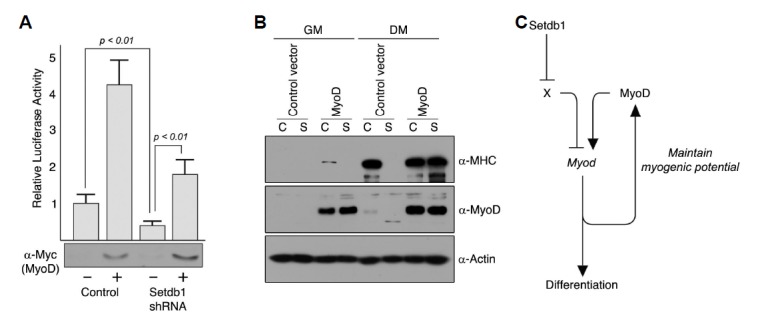Fig. 6.

Exogenous MyoD can restore myogenic potential in Setdb1-depleted C2C12 myoblast cells. (A) Exogenous MyoD can transactivate MyoD-luciferase reporter in C2C12 cells depleted of Setdb1. C2C12 cells stably expressing Setdb1 shRNA or control vector were transfected with plasmid expressing myc-MyoD together with a MyoD-luciferase reporter. The empty vector (pcDNA3) was added to adjust the total amount of transfected DNA to 1.0 μg. Data are presented as relative luciferase activity to the control (empty vector) and expression of exogenous Myc-MyoD was verified by Western blot; Data shown are representative of three independent experiments performed in triplicate, and error bars indicate standard deviation. (B) Proliferating C2C12 myoblast cells stably expressing Setdb1 shRNA or control C2C12 cells were infected with retroviruses expressing MyoD. Empty vector (pLZRS-IRES-GFP) was used as a control. Cells were harvested prior to and 72 hours after induction of differentiation and total proteins were extracted. Differentiation was assessed by western blot analysis using antibody against MHC, and exogenous expression of MyoD was shown to confirm retroviral infection (C) Setdb1 is required for myogenic potential via maintenance of endogenous MyoD expression. In our proposed model, we speculate that Setdb1 inhibits repressor (X) of MyoD that could compete with MyoD in normal proliferating C2C12 myoblast cells. However, depletion of Setdb1 leads to inhibition of differentiation as this potential repressor is relieved from suppression.
